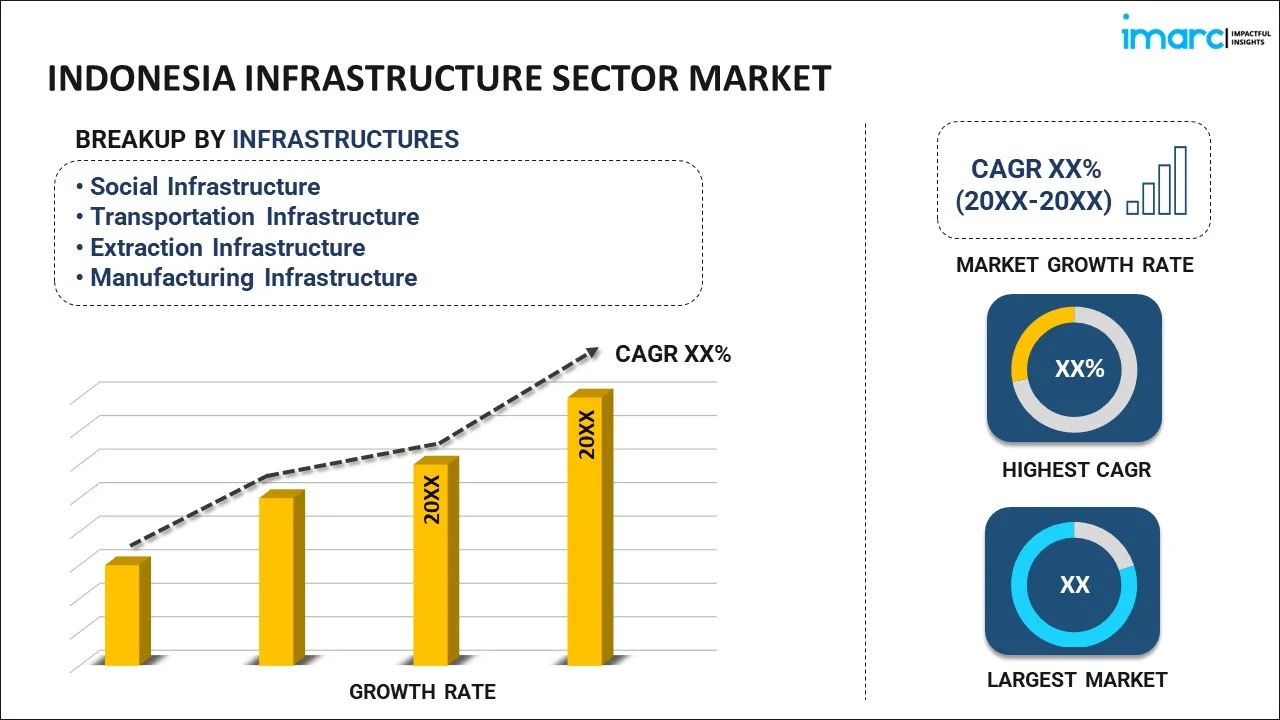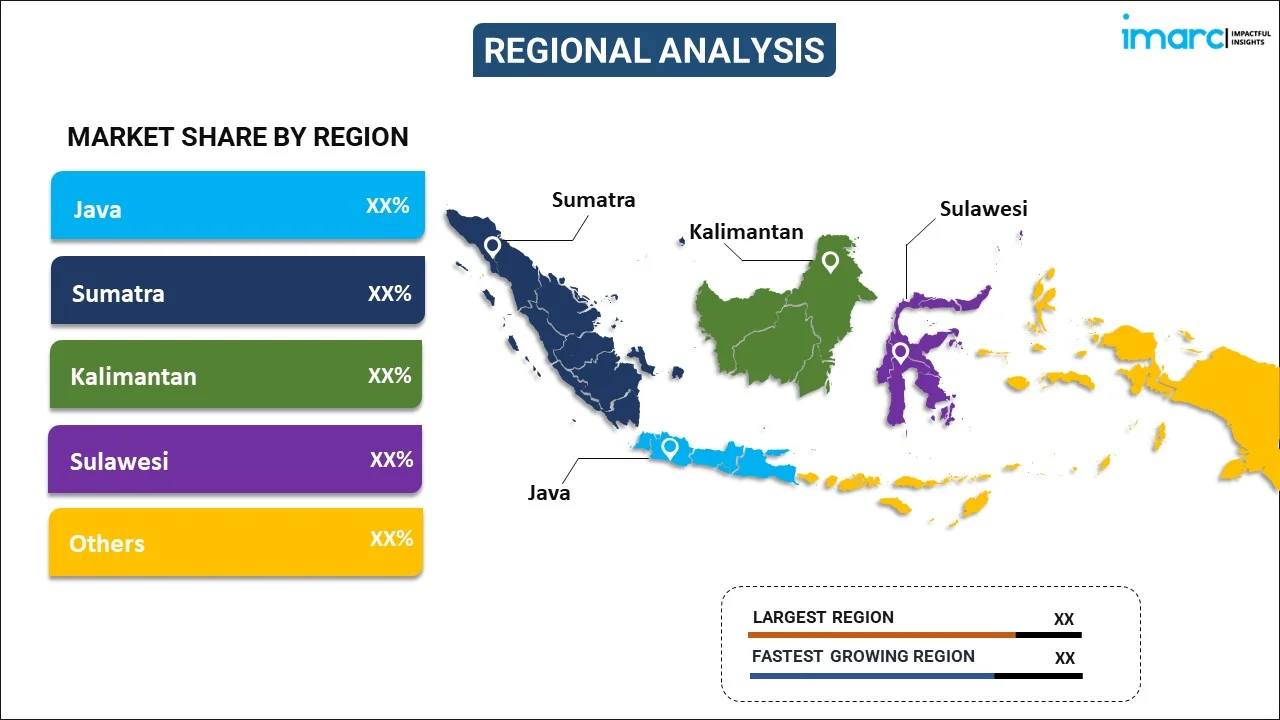
Indonesia Infrastructure Sector Market Report by Infrastructure (Social Infrastructure, Transportation Infrastructure, Extraction Infrastructure, Manufacturing Infrastructure), and Region 2025-2033
Market Overview:
Indonesia infrastructure sector market size reached USD 35.0 Billion in 2024. Looking forward, IMARC Group expects the market to reach USD 55.1 Billion by 2033, exhibiting a growth rate (CAGR) of 5.16% during 2025-2033. The government's enhanced focus on the upgradation and expansion of the country's infrastructure, numerous innovations in public transportation, housing, and utility services, rising technological adoption, particularly in manufacturing and the digital economy, and continual technological advancements represent some of the key factors driving the market.
|
Report Attribute
|
Key Statistics
|
|---|---|
|
Base Year
|
2024 |
|
Forecast Years
|
2025-2033
|
|
Historical Years
|
2019-2024
|
| Market Size in 2024 | USD 35.0 Billion |
| Market Forecast in 2033 | USD 55.1 Billion |
| Market Growth Rate (2025-2033) | 5.16% |
The infrastructure sector is a critical component of any economy, encompassing a broad range of facilities and systems that facilitate essential services and activities. This includes transportation systems, including roads, bridges, airports, and railways; utilities, such as electricity, water supply, and telecommunications; and public institutions, such as schools, hospitals, and government buildings. Infrastructure is generally divided into two types: hard and soft. Hard infrastructure refers to the physical systems and structures, including roads and bridges, that form the backbone of modern society. Soft infrastructure, on the other hand, involves human capital and institutions that help deliver social services, such as healthcare and education. One of the key advantages of a well-developed infrastructure is that it contributes to economic growth by enhancing productivity, facilitating trade, and creating jobs. An efficient transportation system reduces the time and cost of moving goods and people, thereby boosting commercial activities. Similarly, a reliable energy grid ensures that industries can operate without interruption, contributing to increased output and competitiveness.
Indonesia Infrastructure Sector Market Trends:
The market in Indonesia is majorly driven by its increasing importance in the regional and global context. Along with this, the Indonesian government's strong commitment to upgrading and expanding the country's infrastructure through substantial investments and public-private partnerships is significantly supporting the market. This commitment is evidenced by various mega-projects, including the construction of new airports, seaports, and highways aimed at bolstering economic activities and connectivity. In addition, the rapidly growing urban population, necessitating advancements in public transportation, housing, and utility services, is favoring the market. This demographic shift creates an urgent need for modern, reliable infrastructure to support the burgeoning urban centers. Technology adoption within the sector is also on the rise, with smart city initiatives and the use of digital technologies, such as IoT sensors and data analytics, to improve the efficiency and sustainability of infrastructure systems. Moreover, Indonesia's strategic geographic location as an archipelago connecting key trade routes is influencing demand for more robust and efficient maritime and shipping facilities. The rising technological adoption, particularly in manufacturing and the digital economy, also require reliable energy and utility services, further propelling the market. Apart from this, sustainability is emerging as a new trend, with a growing focus on eco-friendly, resilient infrastructure that can withstand natural calamities and contribute to environmental conservation. Green construction materials, renewable energy integration, and waste management systems are some of the areas receiving increased attention. Furthermore, favorable government policies, demographic shifts, technological adoption, and a growing emphasis on sustainable development are creating a positive market outlook.
Indonesia Infrastructure Sector Market Segmentation:
IMARC Group provides an analysis of the key trends in each segment of the market, along with forecasts at the country level for 2025-2033. Our report has categorized the market based on infrastructure.
Infrastructure Insights:

- Social Infrastructure
- Schools
- Hospitals
- Defense
- Others
- Transportation Infrastructure
- Railways
- Roadways
- Airports
- Waterways
- Extraction Infrastructure
- Power Generation
- Electricity Transmission and Distribution
- Water
- Gas
- Telecoms
- Manufacturing Infrastructure
- Metal and Ore Production
- Petroleum Refining
- Chemical Manufacturing
- Industrial Parks and Clusters
- Others
The report has provided a detailed breakup and analysis of the market based on the infrastructure. This includes social infrastructure (schools, hospitals, defence, and others), transportation infrastructure (railways, roadways, airports, and waterways), extraction infrastructure (power generation, electricity transmission and distribution, water, gas, and telecoms), and manufacturing infrastructure (metal and ore production, petroleum refining, chemical manufacturing, industrial parks and clusters, and others).
Regional Insights:

- Java
- Sumatra
- Kalimantan
- Sulawesi
- Others
The report has also provided a comprehensive analysis of all the major regional markets, which include Java, Sumatra, Kalimantan, Sulawesi, and Others.
Competitive Landscape:
The market research report has also provided a comprehensive analysis of the competitive landscape in the market. Competitive analysis such as market structure, key player positioning, top winning strategies, competitive dashboard, and company evaluation quadrant has been covered in the report. Also, detailed profiles of all major companies have been provided. Some of the key players include:
- PT. ACSET Indonusa Tbk
- PT. Adhi Karya (Persero) Tbk
- PT. Brantas Abipraya (Persero)
- PT. Hutama Karya (Persero)
- PT. Indonesia Pondasi Raya Tbk
- PT. Jagat Konstruksi Abdipersada
- PT. Jasa Marga (Persero)
- PT. Jaya Konstruksi Manggala Pratama Tbk (PT Pembangunan Jaya Ancol Tbk)
- PT. Kajima Indonesia
(Please note that this is only a partial list of the key players, and the complete list is provided in the report.)
Indonesia Infrastructure Sector Market Report Coverage:
| Report Features | Details |
|---|---|
| Base Year of the Analysis | 2024 |
| Historical Period | 2019-2024 |
| Forecast Period | 2025-2033 |
| Units | Billion USD |
| Scope of the Report | Exploration of Historical and Forecast Trends, Industry Catalysts and Challenges, Segment-Wise Historical and Predictive Market Assessment:
|
| Infrastructures Covered |
|
| Regions Covered | Java, Sumatra, Kalimantan, Sulawesi, Others |
| Companies Covered | PT. ACSET Indonusa Tbk, PT. Adhi Karya (Persero) Tbk, PT. Brantas Abipraya (Persero), PT. Hutama Karya (Persero), PT. Indonesia Pondasi Raya Tbk, PT. Jagat Konstruksi Abdipersada, PT. Jasa Marga (Persero), PT. Jaya Konstruksi Manggala Pratama Tbk (PT Pembangunan Jaya Ancol Tbk), PT. Kajima Indonesia, etc. |
| Customization Scope | 10% Free Customization |
| Post-Sale Analyst Support | 10-12 Weeks |
| Delivery Format | PDF and Excel through Email (We can also provide the editable version of the report in PPT/Word format on special request) |
Key Questions Answered in This Report:
- How has the Indonesia infrastructure sector market performed so far and how will it perform in the coming years?
- What has been the impact of COVID-19 on the Indonesia infrastructure sector market?
- What is the breakup of the Indonesia infrastructure sector market on the basis of infrastructure?
- What are the various stages in the value chain of the Indonesia infrastructure sector market?
- What are the key driving factors and challenges in the Indonesia infrastructure sector?
- What is the structure of the Indonesia infrastructure sector market and who are the key players?
- What is the degree of competition in the Indonesia infrastructure sector market?
Key Benefits for Stakeholders:
- IMARC’s industry report offers a comprehensive quantitative analysis of various market segments, historical and current market trends, market forecasts, and dynamics of the Indonesia infrastructure sector market from 2019-2033.
- The research report provides the latest information on the market drivers, challenges, and opportunities in the Indonesia infrastructure sector market.
- Porter's five forces analysis assist stakeholders in assessing the impact of new entrants, competitive rivalry, supplier power, buyer power, and the threat of substitution. It helps stakeholders to analyze the level of competition within the Indonesia infrastructure sector industry and its attractiveness.
- Competitive landscape allows stakeholders to understand their competitive environment and provides an insight into the current positions of key players in the market.
Need more help?
- Speak to our experienced analysts for insights on the current market scenarios.
- Include additional segments and countries to customize the report as per your requirement.
- Gain an unparalleled competitive advantage in your domain by understanding how to utilize the report and positively impacting your operations and revenue.
- For further assistance, please connect with our analysts.
 Inquire Before Buying
Inquire Before Buying
 Speak to an Analyst
Speak to an Analyst
 Request Brochure
Request Brochure
 Request Customization
Request Customization




.webp)




.webp)












